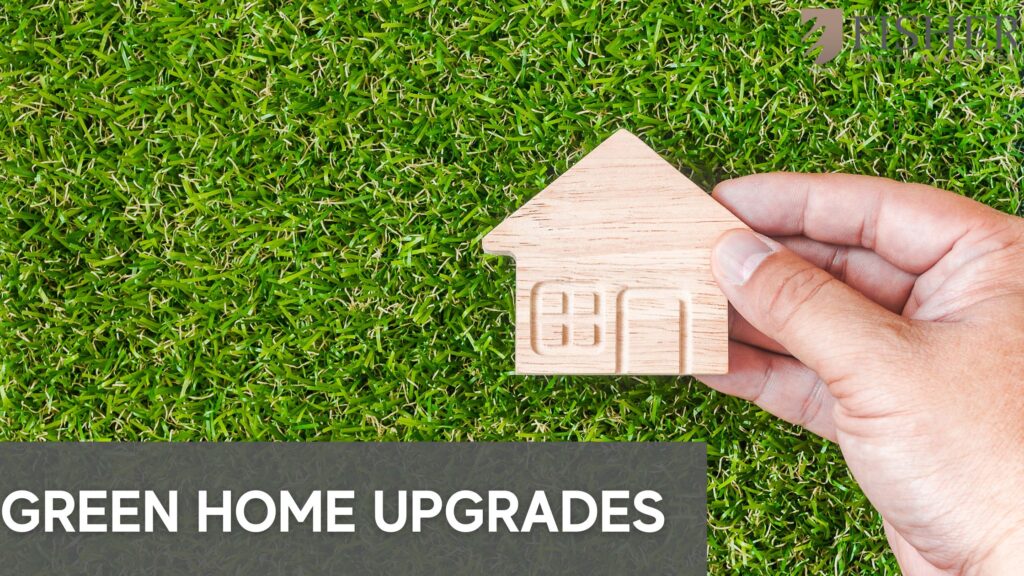
Green Home Upgrades
When something is labeled eco-friendly, it can have a variety of meanings. It could indicate that a material is sustainably sourced, for example. Or it could signify that a particular setup is more energy efficient.
When it comes to your home, going green can mean making upgrades that fulfill both of those definitions and beyond. Make the following changes to reap the benefits of energy efficiency in every part of your home.
Exterior Options
Your home’s outdoor features will need repair as they age. Exterior upgrades can be an investment, so make sure you’re spending your money on the best solutions.
A cool roof
Have you ever entered a car with black leather seats on a summer day? If so, you know that certain materials, especially dark-colored or black ones, are notorious for absorbing heat. And roofs are no different: a black roof can reach around 170 degrees Fahrenheit on a hot day. Roof heat absorption can be helpful in the winter to melt snow but has little use any other time of year. If you’re going to upgrade your roof to something more eco-friendly, opt for a cool roof. This option uses materials such as wood, specially painted metal, or custom shingles to reflect heat away instead of absorbing it. While you may spend more up front, the switch to this efficient style of roof can potentially save you more money in the long term by reducing your energy costs and providing you a possible tax rebate or credit.
Double-paned windows
Drafts from windows can be costly over time. If you don’t already have double-paned windows, they should be on the top of your home-improvement priority list. Traditional single-paned windows only have one sheet of glass and no insulation, so elements from the outside can find a way inside. However, dual-paned windows have a thin layer of separation between two sheets of glass, usually filled with insulating gas. These insulated windows cost more but offer benefits such as stabilizing your home’s temperature, lowering your energy costs, insulating your home from exterior noise, and adding to your home’s overall value. And if you want to go the extra mile with potential cost-saving, consider triple-paned windows.
Windbreaking/treescaping
Protecting your home from strong winds may not seem like an eco-friendly task, but your home can suffer from wind chill too. While you may not feel the chill, it can affect your home’s energy efficiency. Windbreaking, also known as treescaping, is a strategic placement (usually to the north) of dense evergreen trees and shrubs around a home to shield it from harsh winds that would otherwise force its heating system to work overtime. Be sure to hire a landscaper who is familiar with this practice so they can arrange the greenery in an optimal way and at a safe distance from your home. At the end of the project, you’ll have energy savings and great landscaping to increase your home’s curb appeal. Plus, what’s more eco-friendly than planting trees?
Interior Improvements
A comfortable home is a happy home. However, there is a common misconception that to enjoy modern home amenities, you have to sacrifice being eco-friendly. In reality, this couldn’t be further from the truth. You can keep the comforts you love without expending an exorbitant amount of energy. The following changes can help you transition into a low-carbon-footprint lifestyle.
A smart/programmable thermostat
Manual thermostats offer no more than the ability to change the temperature. Make the switch to a smart thermostat, such as Nest, to enjoy features like scheduled temperature changes, zoned temperature control based on room occupancy, and automatic adjustments based on the weather in your area. These features are not only convenient but also helpful to your energy bill and the stress on your HVAC unit. From an eco-friendly perspective, it’s important to consider how often you’re pushing your HVAC to its limits, as running it constantly produces more carbon dioxide that’s released into the atmosphere. Installing a smart thermostat can extend your system’s lifespan and limit the time that it’s needlessly running.
A tankless water heater
About one-fifth of your energy bill goes toward hot water; a shower here, a load of laundry there, and washing the dishes can add up quickly. Standard residential water heaters hold twenty to eighty gallons of water, and research indicates that a typical household can use around forty to sixty gallons of hot water a day on average. You could potentially be heating water you don’t use right away, so consider a tankless water heater to help you save energy and money. Instead of holding water, water gets pumped through it at a set flow rate measured in gallons per minute. Tankless water heaters deliver hot water on demand, so you won’t heat any water you don’t need. Besides using less water and heat, these efficient gadgets have a longer lifespan of twenty to twenty-five years and require less space to install. Be sure to talk to an electrician about your options and avoid gas-powered tankless water heaters as the return in energy efficiency will be negligible.
There’s no time like the present to make green upgrades to your home. Try these energy-efficient ideas today to better the planet and your bank account.
This article was prepared by ReminderMedia.
LPL Tracking #1-05367305